IoT Sensing-Based High-Density Monitoring of Urban Roadside Particulate Matter (PM10 and PM2.5)
Abstract
1. Introduction
2. Literature Review
3. Methodology
3.1. Development of IoT Devices
| { |
| “device_id”: “RSPM-0001”, |
| “latitude”: “xxx.xxxxxxx”, |
| “longitude”: “yyy.yyyyyyy”, |
| “timestamp”: “2025-07-06T14:33:02Z”, |
| “pm1_0”: 18, |
| “pm2_5”: 26, |
| “pm10”: 41, |
| “temp”: 26.4, |
| “humidity”: 74.3, |
| “pressure”: 1005.7 |
| { |
3.2. Seasonal Environmental Conditions
3.3. Spatial Environmental Conditions
3.3.1. Subsubsection Integration with Public Monitoring Networks
3.3.2. Site Selection Criteria
- (a)
- Traffic Island (High-Exposure Site)
- (b)
- Rooftop (Dispersion Site)
- (c)
- Shielded Roadside (Vegetation Buffer Site)
3.3.3. Temporal Normalization
3.4. Quantitative Analysis
3.4.1. Similarity Measurement
3.4.2. PM Variability Measurement
4. Results
4.1. Comparison with Public Monitoring Data
4.2. Comparison of PM Concentrations by Time Period
4.2.1. Differences Between Weekdays and Weekends
4.2.2. Differences Between Daytime and Nighttime
4.2.3. Reliability of IoT Devices Compared with Public Monitoring Stations
4.2.4. Time-Series Trends
4.3. IoT Sensing-Based Urban Roadside PM Analysis
4.4. Analysis of PM10 Impulse-like Spikes at TRAFFIC_ISLAND
5. Discussion
5.1. Reliability of the Proposed Approach
5.2. Site-Specific Characteristics and Environmental Influences
5.3. Temporal Trends by Time of Day and Day of Week
5.4. Validity and Applicability of the Analytical Methodology
5.5. Implications and Future Directions
6. Conclusions
Supplementary Materials
Author Contributions
Funding
Data Availability Statement
Acknowledgments
Conflicts of Interest
Abbreviations
| IoT | Internet of Things |
| PM | Particulate Matter |
| MQTT | Message Queuing Telemetry Transport |
| JSON | JavaScript Object Notation |
| CCTV | closed-circuit television |
| LTE | Long-Term Evolution |
| DTW | Dynamic Time Warping |
| VOCs | Volatile Organic Compounds |
References
- National Cancer Center. Outdoor Air Pollution; World Health Organization: Geneva, Switzerland, 2024; Volume 1, pp. 4–6. [Google Scholar]
- Ministry of the Environment. AirKorea. Available online: https://www.airkorea.or.kr/web/ (accessed on 21 August 2025).
- Nijland, M.E. Traffic-Related Air Pollution—The Health Effects Scrutinized. Ph.D. Thesis, Utrecht University, Utrecht, The Netherlands, 2013. [Google Scholar]
- Bein, K.J.; Wallis, C.D.; Silverman, J.L.; Lein, P.J.; Wexler, A.S. Emulating near-roadway exposure to traffic-related air pollution via real-time emissions from a major freeway tunnel system. Environ. Sci. Technol. 2022, 56, 3330–3339. [Google Scholar] [CrossRef]
- Peng, D. Connections between air pollution, traffic and respiratory health. J. Sustain. Sci. Techol. 2022, 2, 25–32. [Google Scholar] [CrossRef]
- Piotrowicz, A.; Połednik, B. Exposure to aerosols particles on an urban road. J. Ecol. Eng. 2019, 20, 27–34. [Google Scholar] [CrossRef]
- Rather, P.A.; Wanganeo, A. Contribution of vehicular traffic towards particulate emission and its effects on human health. Int. J. Geol. Sci. Res. 2018, 5, 110–118. [Google Scholar] [CrossRef]
- Baldauf, R.; Thoma, E.D.; Hays, M.D.; Shores, R.C.; Kinsey, J.S.; Gullett, B.K.; Kimbrough, S.; Isakov, V.; Long, T.C.; Snow, R.; et al. Traffic and meteorological impacts on near-road air quality: Summary of methods and trends from the Raleigh Near-Road Study. J. Air Waste Manag. Assoc. 2008, 58, 865–878. [Google Scholar] [CrossRef]
- Ummul, S.; Rao, K.K. Road transport and their impacts on health. IJEAB 2019, 4, 321–322. [Google Scholar] [CrossRef]
- Wang, Y.; Huang, Z.; Liu, Y.; Yu, Q.; Ma, W. Back-calculation of traffic-related PM10 emission factors based on roadside concentration measurements. Atmosphere 2017, 8, 99. [Google Scholar] [CrossRef]
- Seoul Metropolitan Government. Air Pollution Monitoring Network; Policy Press. Available online: https://www.seoulsolution.kr/en/content/6540 (accessed on 21 August 2025).
- Woo, D.; Lee, S.-B.; Lee, S.J.; Kim, J.Y.; Jin, H.C.; Kim, T.; Bae, G.-N. Spatial distributions of on-road ultrafine particle number concentration on Naebu Express Way in Seoul during winter season. J. Korean Soc. Atmos. Environ. 2013, 29, 10–26. [Google Scholar] [CrossRef][Green Version]
- Kang, H.; Kim, C.; Kang, H.; Lee, J. A Study on the Status of Atmospheric Environment and the Plan of Air Quality Management on the Expressway [Research Report]; Expressway & Transportation Research Institute: Hwaseong, Republic of Korea, 2018; pp. 1–393. [Google Scholar][Green Version]
- Kang, H.; Kim, C.; Lee, J. Monitoring and Reduction Technologies for Improvement of Highway Air Quality [Research Report]; Expressway & Transportation Research Institute: Hwaseong, Republic of Korea, 2020; pp. 1–253. [Google Scholar][Green Version]
- Kim, J.; Kim, C.; Noh, S.; Hwang, E.; Park, D. A study on spatial distribution characteristics of air pollutants in Bucheon-si using mobile laboratory. Part. Aerosol Res. 2021, 17, 9–20. [Google Scholar] [CrossRef]
- Khan, S.; Hassan, Q.; Kumar, K.; Dixit, S.; Sharma, K.; Vivek Kumar, C.; Dhaliwal, N.; Madhu, B. E3S Web Conference. In Proceedings of the 15th International Conference on Materials Processing and Characterization (ICMPC 2023), Newcastle, UK, 5–8 September 2023; Volume 430. [Google Scholar]
- McCarthy, M.C.; Eisinger, D.S.; Hafner, H.R.; Chinkin, L.R.; Roberts, P.T.; Black, K.N.; Clark, N.N.; McMurry, P.H.; Winer, A.M. Particulate matter: A strategic vision for transportation-related research. Environ. Sci. Technol. 2006, 40, 5593–5599. [Google Scholar] [CrossRef]
- Zhang, D.Z.; Peng, Z.R. Near-road fine particulate matter concentration estimation using artificial neural network approach. Int. J. Environ. Sci. Technol. 2014, 11, 2403–2412. [Google Scholar] [CrossRef]
- Jose, J.; Srimuruganandam, B. Investigation of road dust characteristics and its associated health risks from an urban environment. Environ. Geochem. Health 2020, 42, 2819–2840. [Google Scholar] [CrossRef] [PubMed]
- Navarro-Ciurana, D.; Corbella, M.; Meroño, D. Effects of road dust particle size on mineralogy, chemical bulk content, pollution and health risk analyses. Int. J. Environ. Res. Public Health 2023, 20, 6655. [Google Scholar] [CrossRef] [PubMed]
- Choi, W.; Sung, H.; Chong, K.-S. AI-driven particulate matter estimation using urban CCTV: A comparative analysis under various experimental conditions. Appl. Sci. 2024, 14, 9629. [Google Scholar] [CrossRef]
- Garcia-Garza, L.A.; Tello-Leal, E.; Macías-Hernández, B.A.; Romero, G.; Hernandez-Resendiz, J.D. Particulate matter 1 μm (PM1) dataset collected by low-cost sensors in residential and industrial areas at the neighborhood level. Data Brief 2024, 54, 110411. [Google Scholar] [CrossRef]
- Liu, X.; Zhao, Q.; Zhu, S.; Peng, W.; Yu, L. An experimental application of laser-scattering sensor to estimate the traffic-induced PM2.5 in Beijing. Environ. Monit. Assess. 2020, 192, 450. [Google Scholar] [CrossRef]
- Chen, S.; Cui, K.; Yu, T.Y.; Chao, H.R.; Hsu, Y.C.; Lu, I.C.; Arcega, R.D.; Tsai, M.H.; Lin, S.L.; Chao, W.C.; et al. A big data analysis of PM2.5 and PM10 from low cost air quality sensors near traffic areas. Aerosol Air Qual. Res. 2019, 19, 1721–1733. [Google Scholar] [CrossRef]
- Noman Munshi, M.; Nihab Ahsan, S.M.; Shafinur Rahman, M.; Tauhid Ur Rahman, M. Application of low-cost air quality monitoring sensor to assess the exposure of ambient air pollution due to PM2.5 and PM10. In Sustainability in Environmental Engineering and Science; Kumar, S., Kalamdhad, A., Ghangrekar, M.M., Eds.; Springer: Singapore, 2021; pp. 135–148. [Google Scholar] [CrossRef]
- Alfano, B.; Barretta, L.; Del Giudice, A.; De Vito, S.; Di Francia, G.; Esposito, E.; Formisano, F.; Massera, E.; Miglietta, M.L.; Polichetti, T.S. A review of low-cost particulate matter sensors from the developers’ perspectives. Sensors 2020, 20, 6819. [Google Scholar] [CrossRef]
- Raspberry Pi Ltd. Raspberry Pi Zero 2 W—Product Brief. 2024. Available online: https://datasheets.raspberrypi.com/rpizero2/raspberry-pi-zero-2-w-product-brief.pdf (accessed on 21 August 2025).
- Laser Particle Sensor Module (PM2008M-M) Specification. 2020. Available online: https://en.gassensor.com.cn/Product_files/Specifications/PM2008M-M%20Laser%20Particle%20Sensor%20Module%20Specification.pdf (accessed on 21 August 2025).
- OASIS. MQTT Version 3.1.1. Plus Errata 01; OASIS Standard. 2015. Available online: https://docs.oasis-open.org/mqtt/mqtt/v3.1.1/os/mqtt-v3.1.1-os.html (accessed on 21 August 2025).
- The JavaScript Object Notation (JSON) Data Interchange Format; RFC 8259; Bray, T., Ed.; IETF: Wilmington, DE, USA, 2017. [Google Scholar] [CrossRef]
- Kim, D.; Choi, H.-E.; Gal, W.-M.; Seo, S. Five year trends of particulate matter concentrations in Korean regions (2015–2019): When to ventilate? Int. J. Environ. Res. Public Health 2020, 17, 5764. [Google Scholar] [CrossRef]
- Allabakash, S.; Lim, S.; Chong, K.-S.; Yamada, T.J. Particulate matter concentrations over South Korea: Impact of meteorology and other pollutants. Remote Sens. 2022, 14, 4849. [Google Scholar] [CrossRef]
- Stein, A.F.; Draxler, R.R.; Rolph, G.D.; Stunder, B.J.B.; Cohen, M.D.; Ngan, F. NOAA’s HYSPLIT atmospheric transport and dispersion modeling system. Bull. Am. Meteorol. Soc. 2015, 96, 2059–2077. [Google Scholar] [CrossRef]
- Pearson, K. VII. Note on regression and inheritance in the case of two parents. Proc. R. Soc. Lond. 1895, 58, 240–242. [Google Scholar] [CrossRef]
- Box, G.E.P.; Jenkins, G.M. Time Series Analysis: Forecasting and Control; Holden-Day: San Francisco, CA, USA, 1970. [Google Scholar]
- Sakoe, H.; Chiba, S. Dynamic programming algorithm optimization for spoken word recognition. IEEE Trans. Acoust. Speech Signal Process. 1978, 26, 43–49. [Google Scholar] [CrossRef]
- Zhang, F.; Yan, R.; Ye, X.; Fei, L.; Zhu, Y.; Chen, X.; Zhu, S.; Qi, B.; Xu, D.; Li, W. Machine learning and causal inference for disentangling air pollution reduction during the asian games in megacity hangzhou. Environ. Pollution. 2025, 382, 126775. [Google Scholar] [CrossRef]
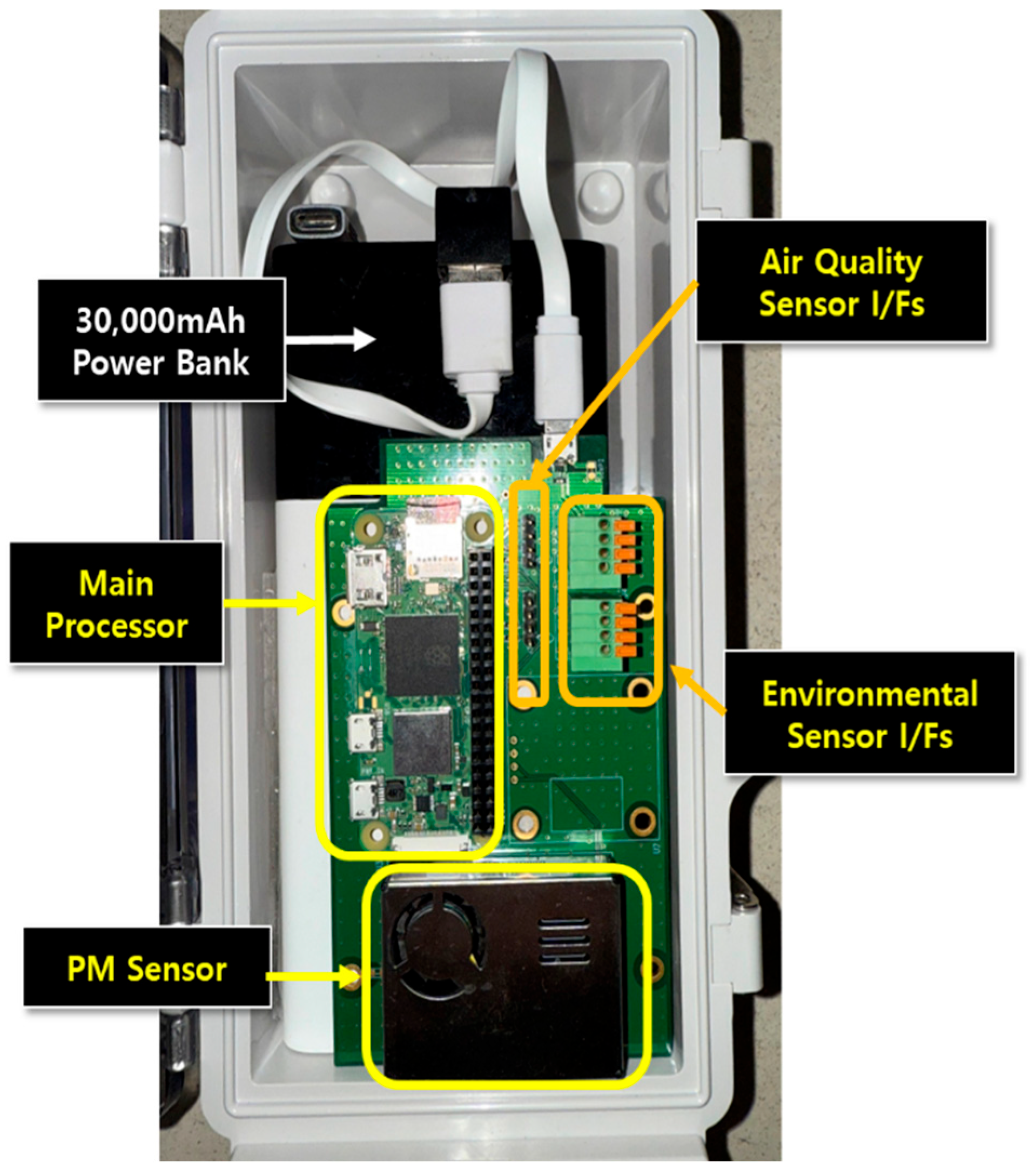
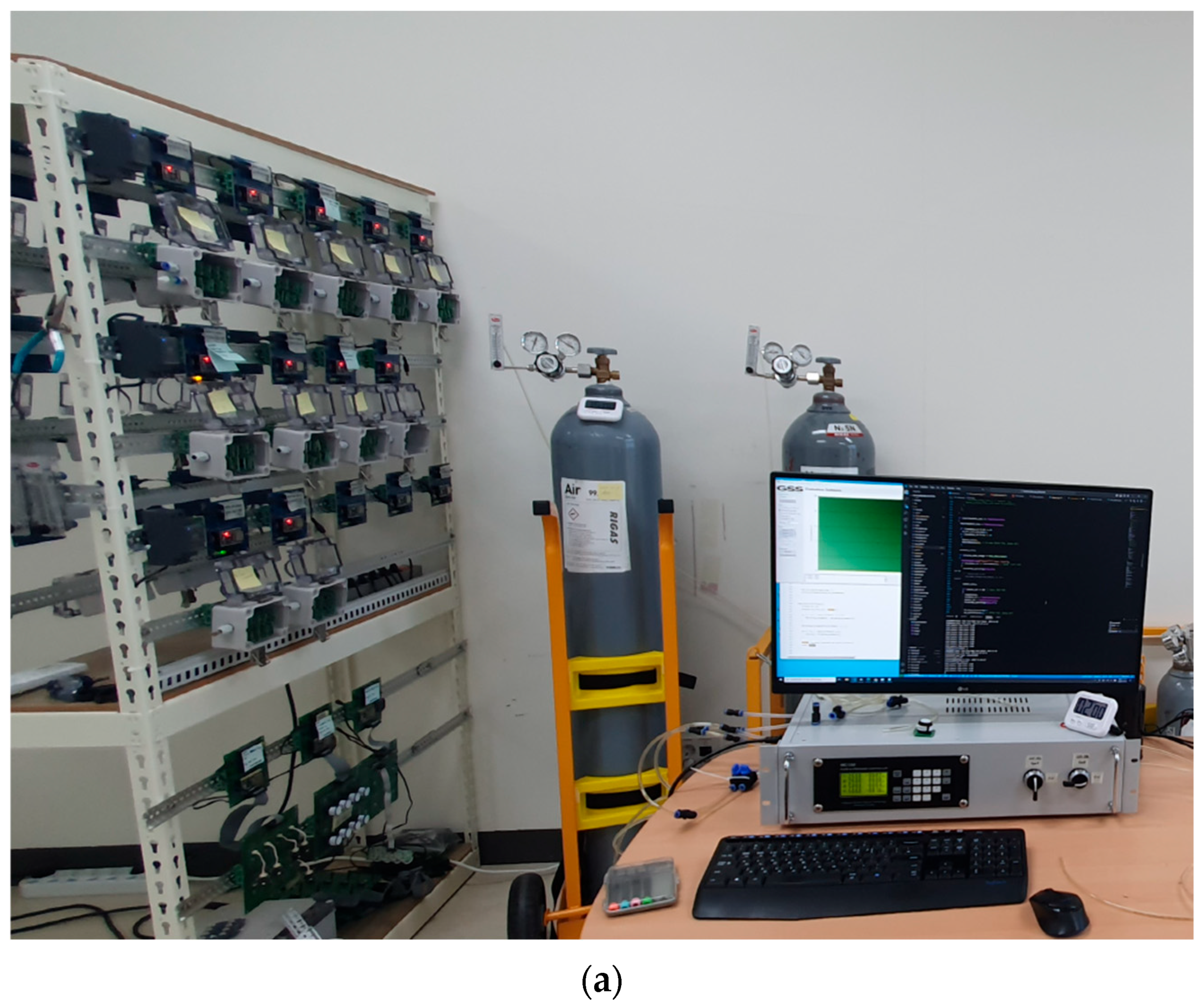
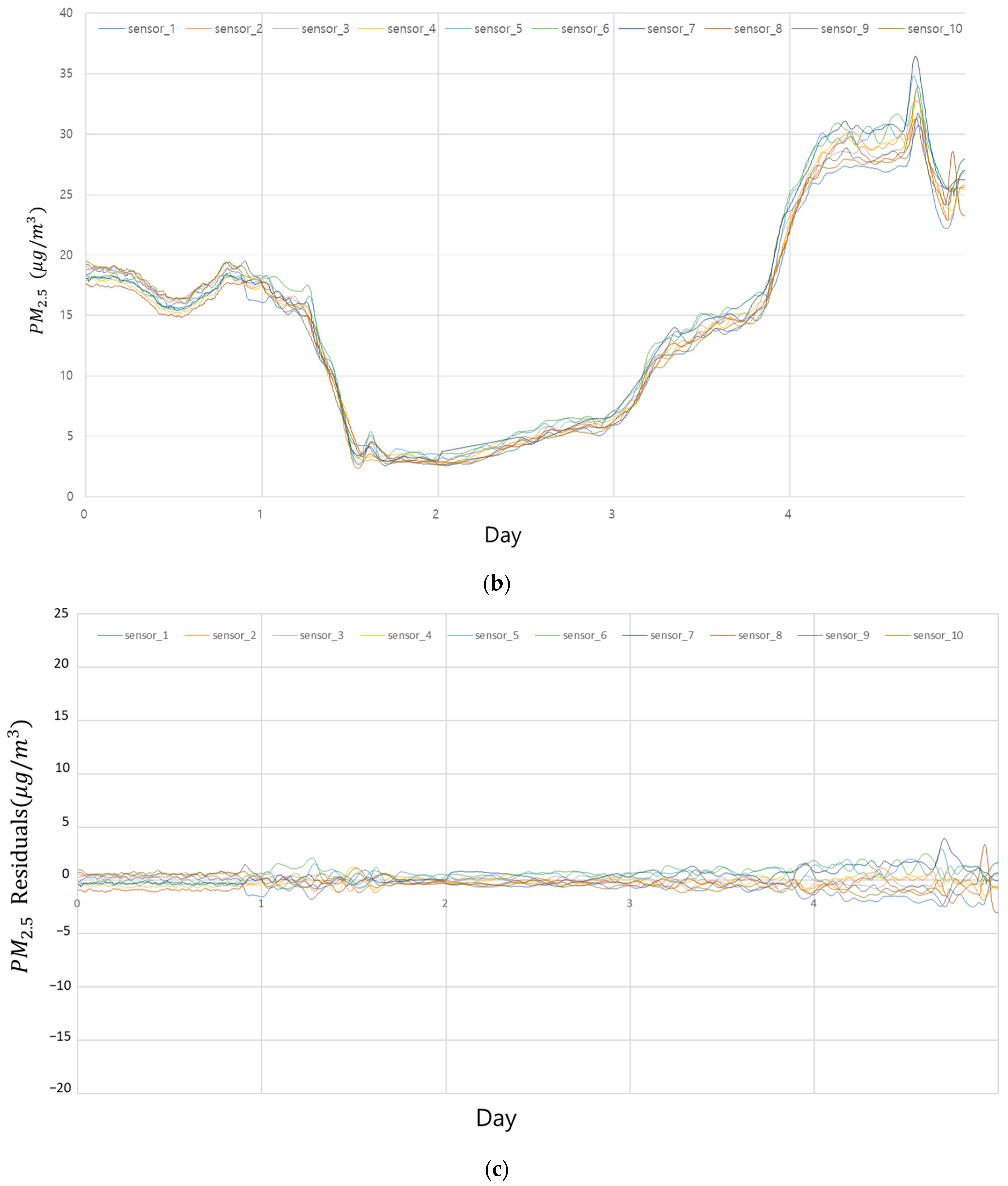
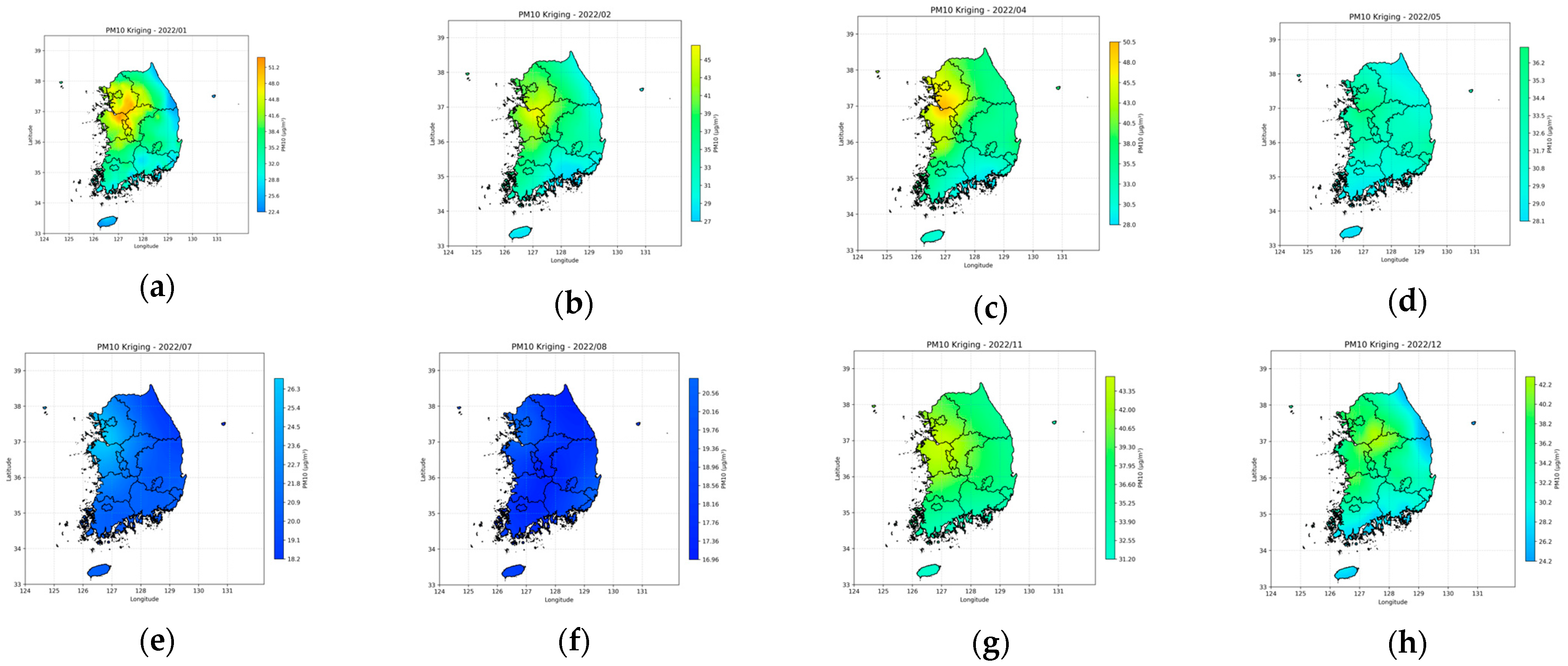
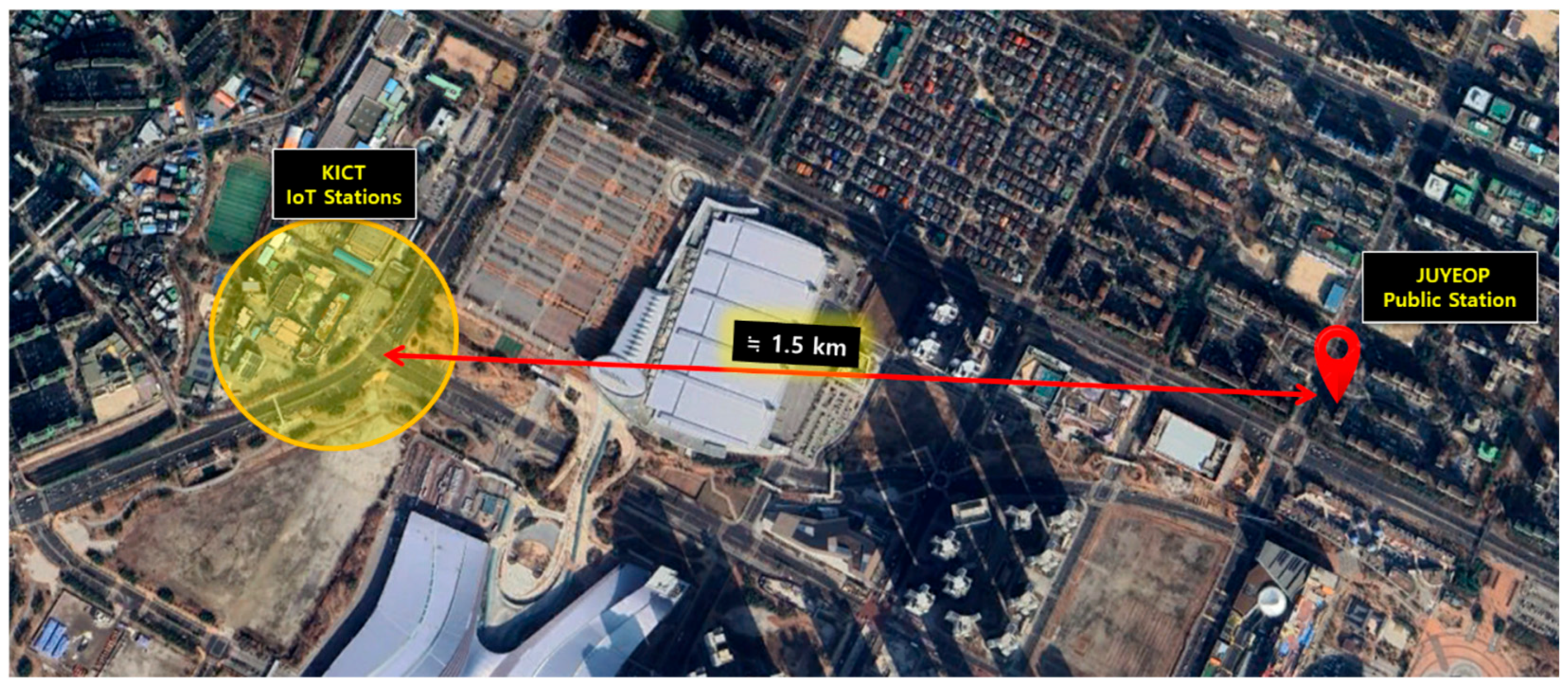
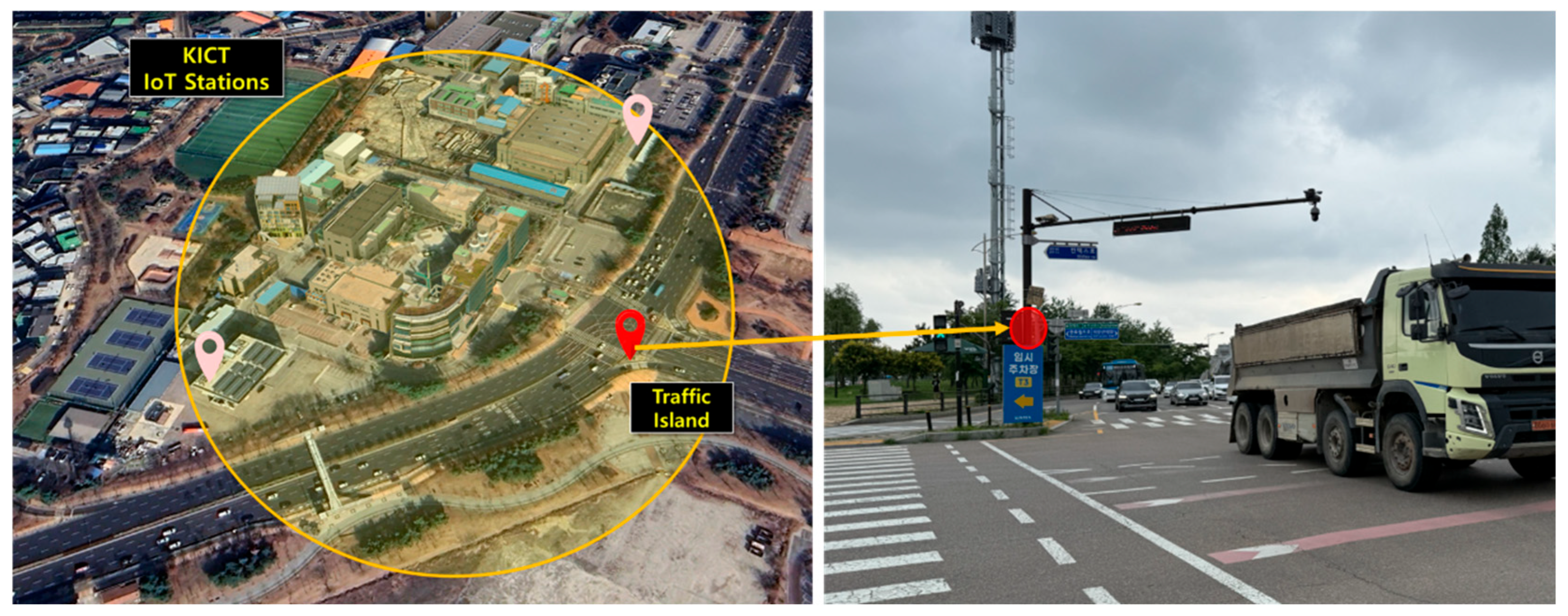
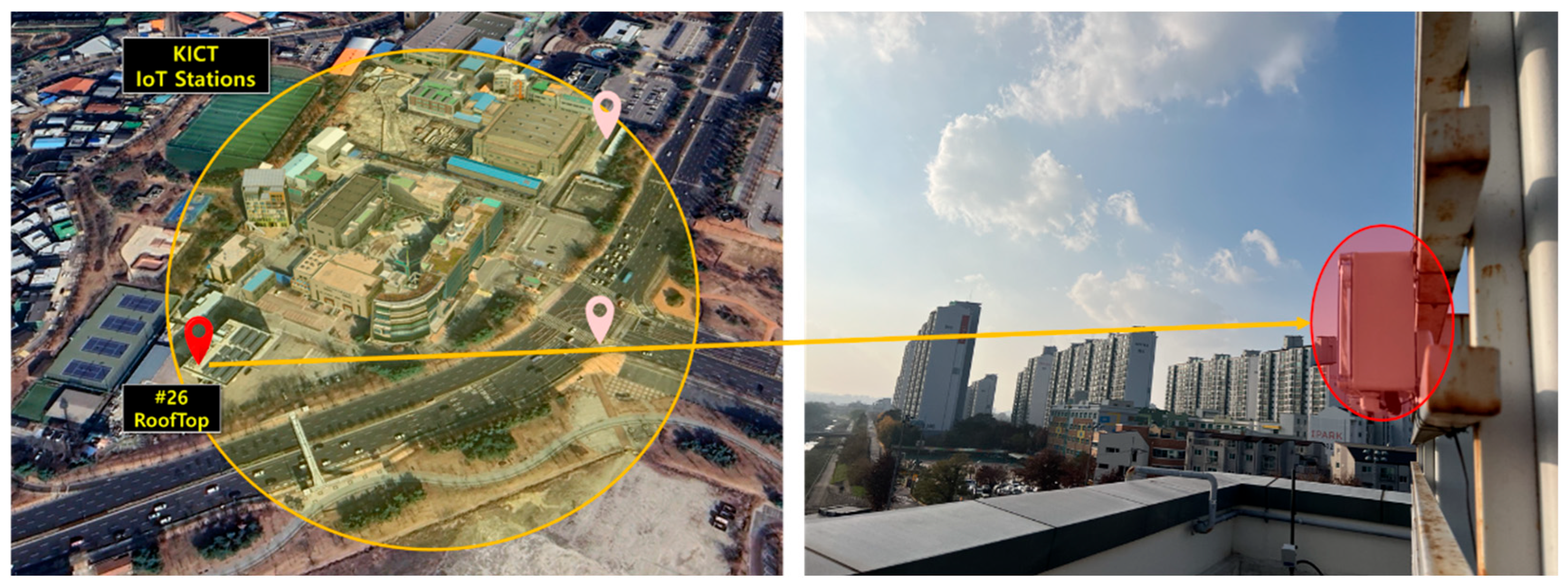
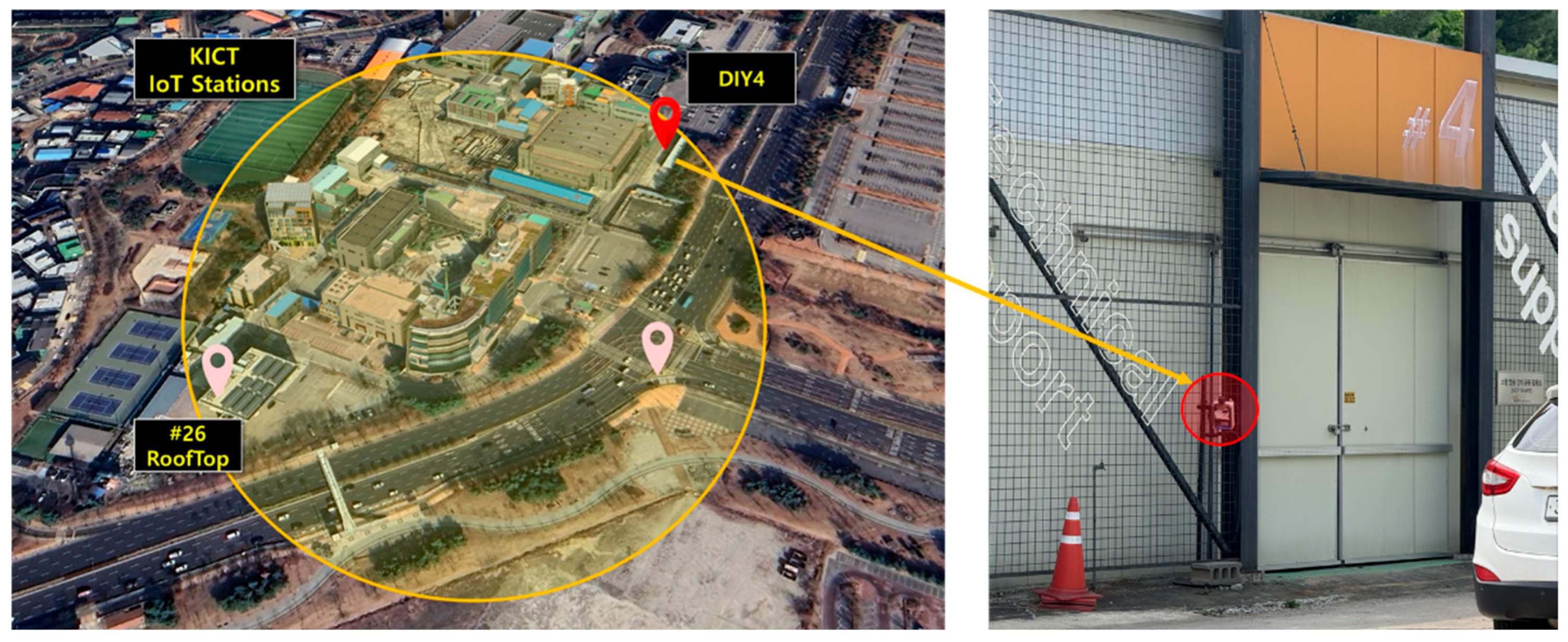
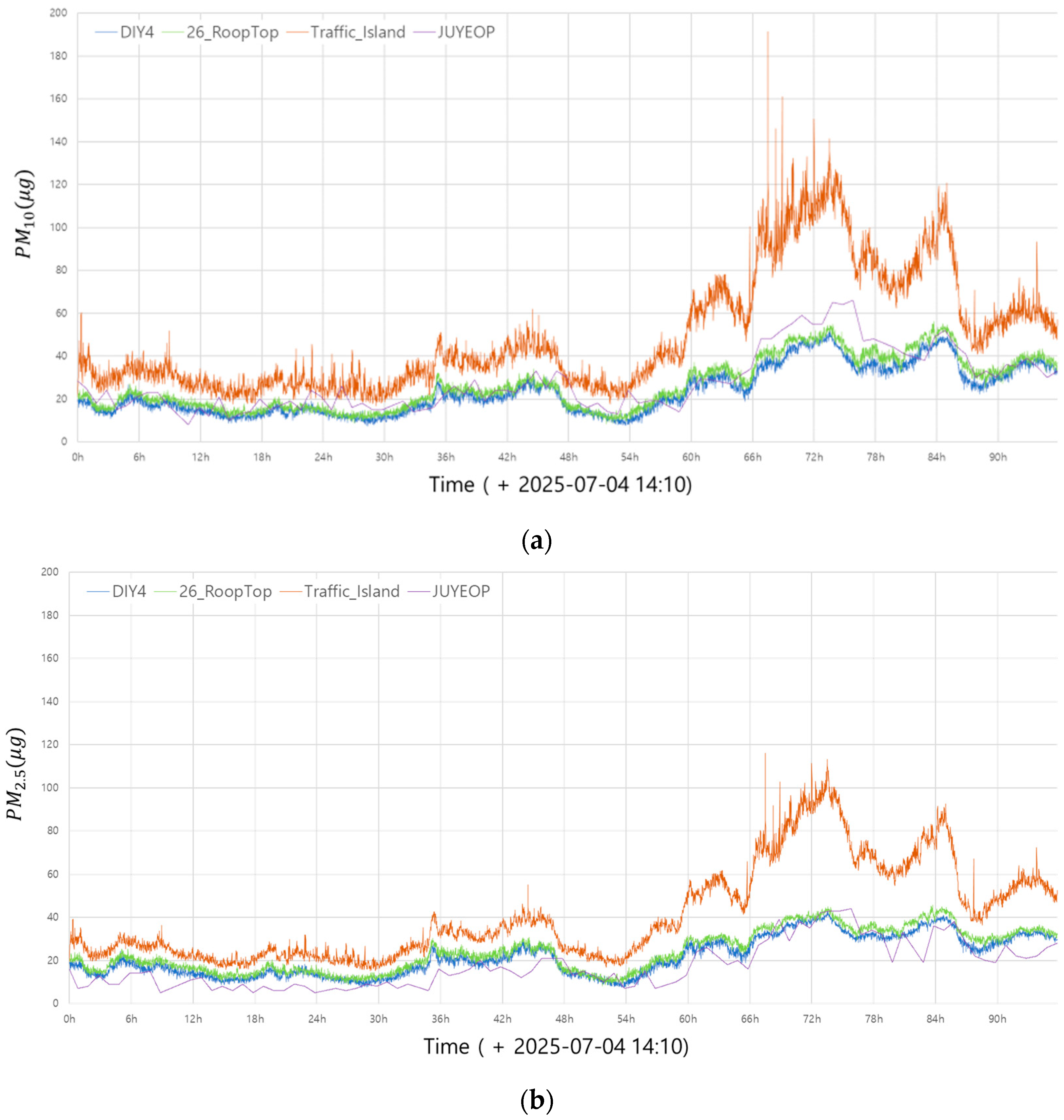
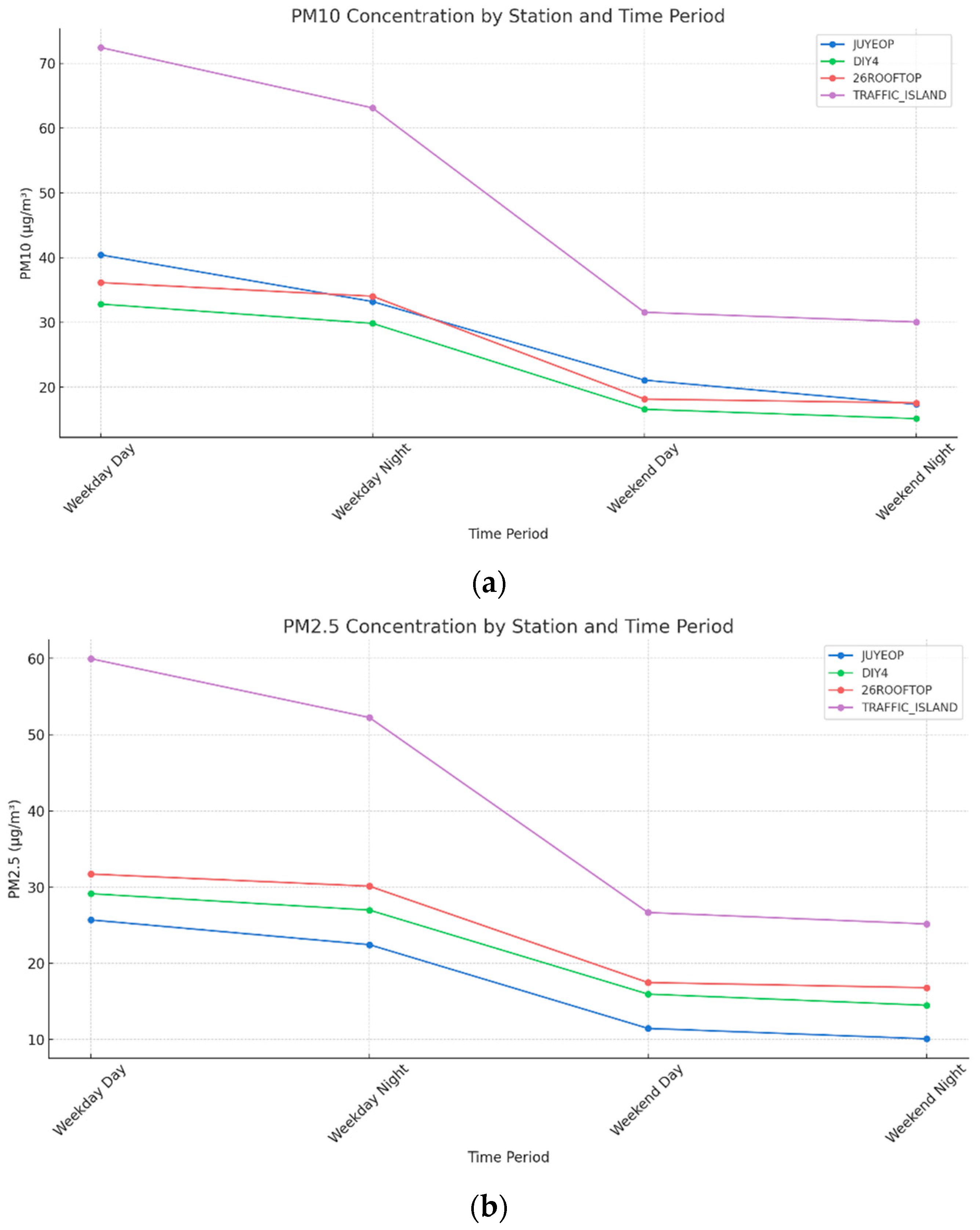
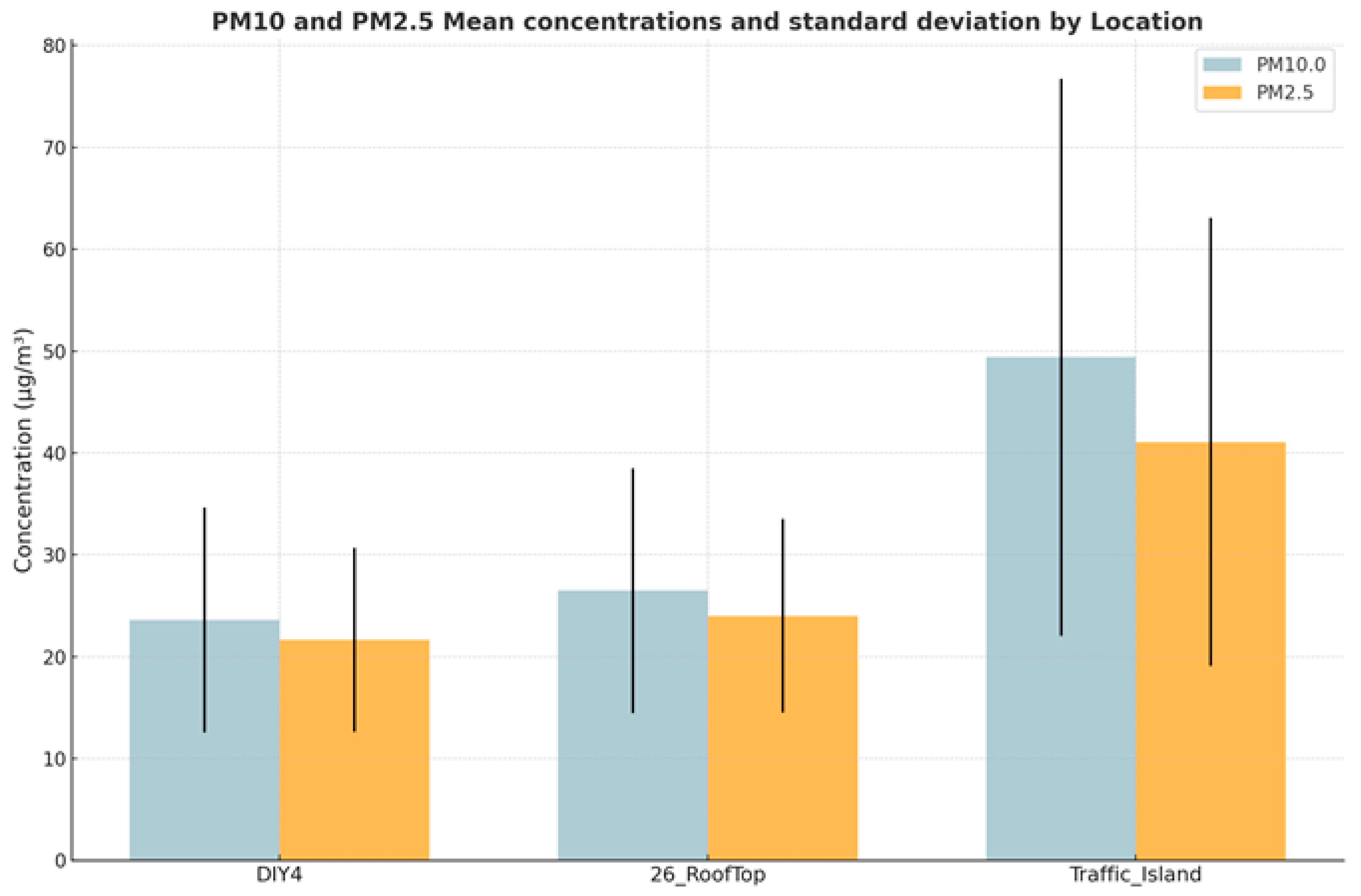
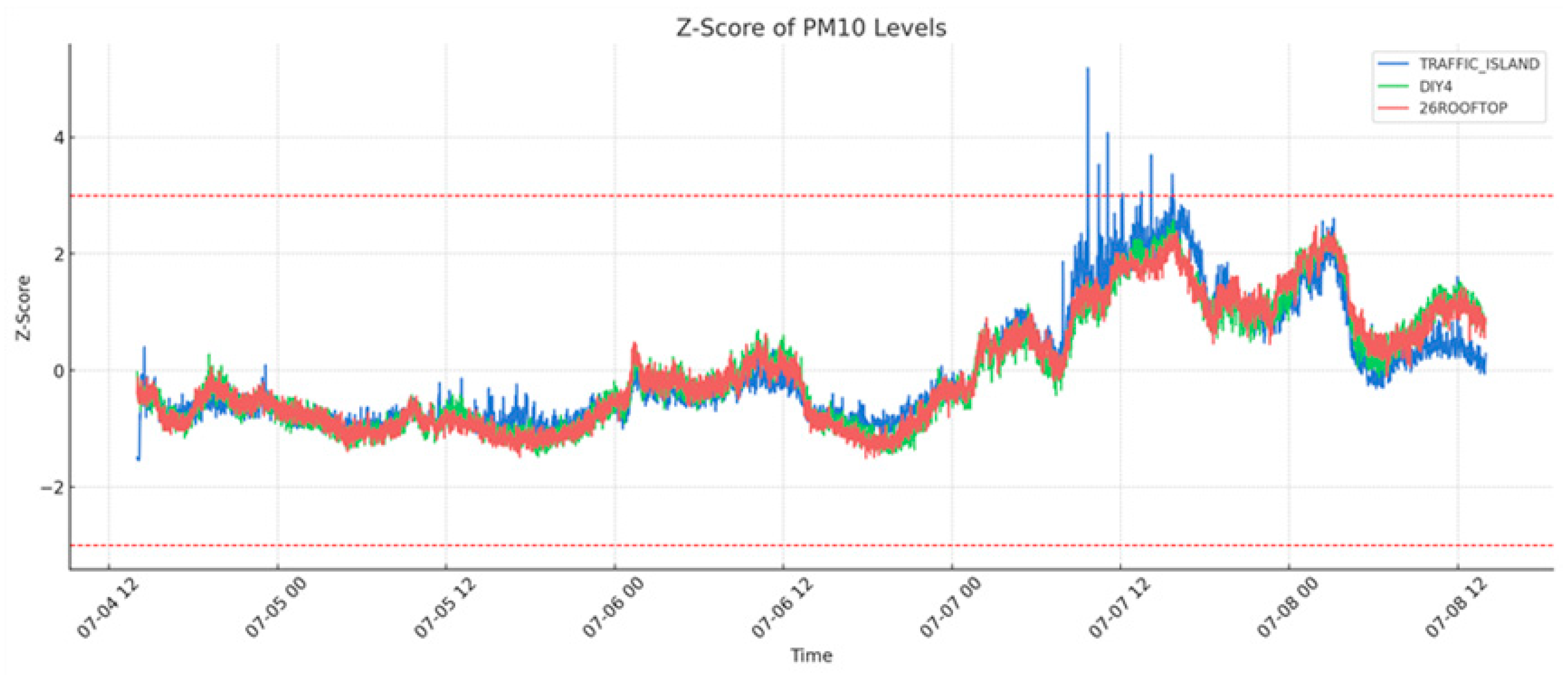
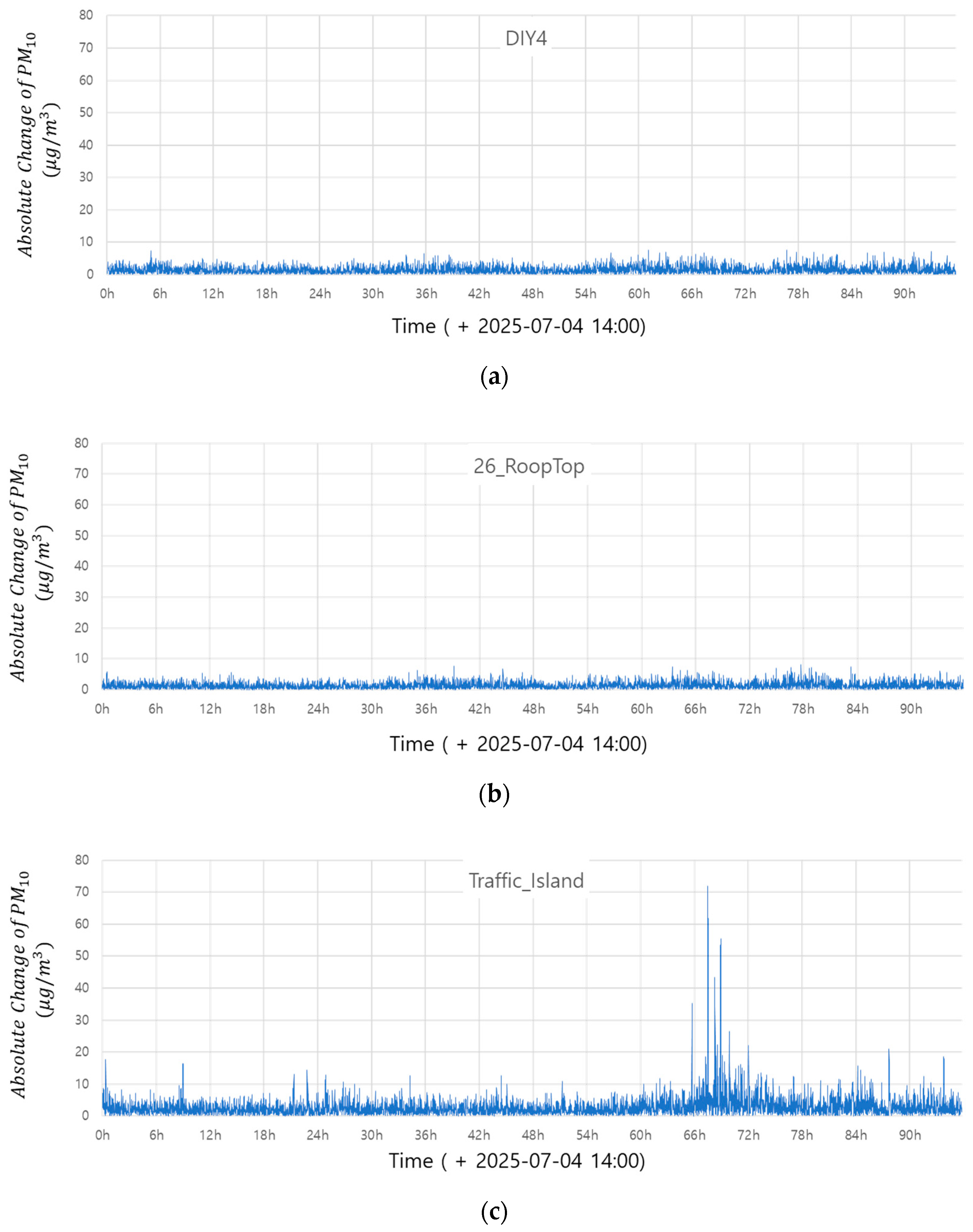
| Station | Sampling Interval | Location | Distance from Road | Expected PM Impact |
|---|---|---|---|---|
| JUYEOP | 1 h (upsampled) | 4th floor rooftop, public air quality station | Relatively far and elevated | Baseline reference, low variability |
| DIY4 | 1 s (1-min avg) | Roadside, behind trees & buildings (shielded) | Not directly connected, indirect influence | Possibly lower due to shielding |
| 26ROOFTOP | 1 s (1-min avg) | Near road, rooftop of 3rd floor building | Close but elevated (diffusion is possible) | Moderate level due to dilution |
| TRAFFIC_ISLAND | 1 s (1-min avg) | Traffic island at 8-lane intersection | Very close, directly exposed | High variability due to direct exposure |
| Site | Pearson Correlation | Cross-Correlation (Lag 0) | Dynamic Time Warping (DTW) Distance |
|---|---|---|---|
| DIY4 | 0.8989 | 0.8988 | 13,380.18 |
| 26ROOFTOP | 0.8996 | 0.8995 | 11,516.55 |
| TRAFFIC_ISLAND | 0.9228 | 0.9226 | 70,733.55 |
| Site | Pearson Correlation | Cross-Correlation (Lag 0) | DTW Distance |
|---|---|---|---|
| DIY4 | 0.8866 | 0.8864 | 13,312.14 |
| 26ROOFTOP | 0.8834 | 0.8833 | 22,342.81 |
| TRAFFIC_ISLAND | 0.9153 | 0.9151 | 97,776.32 |
| Site | Roulette Index |
|---|---|
| DIY4 | 1.271 |
| 26ROOFTOP | 1.284 |
| TRAFFIC_ISLAND | 0.884 |
Disclaimer/Publisher’s Note: The statements, opinions and data contained in all publications are solely those of the individual author(s) and contributor(s) and not of MDPI and/or the editor(s). MDPI and/or the editor(s) disclaim responsibility for any injury to people or property resulting from any ideas, methods, instructions or products referred to in the content. |
© 2025 by the authors. Licensee MDPI, Basel, Switzerland. This article is an open access article distributed under the terms and conditions of the Creative Commons Attribution (CC BY) license (https://creativecommons.org/licenses/by/4.0/).
Share and Cite
Jang, B.-J.; Park, N.; Jung, I. IoT Sensing-Based High-Density Monitoring of Urban Roadside Particulate Matter (PM10 and PM2.5). Appl. Sci. 2025, 15, 11608. https://doi.org/10.3390/app152111608
Jang B-J, Park N, Jung I. IoT Sensing-Based High-Density Monitoring of Urban Roadside Particulate Matter (PM10 and PM2.5). Applied Sciences. 2025; 15(21):11608. https://doi.org/10.3390/app152111608
Chicago/Turabian StyleJang, Bong-Joo, Namjune Park, and Intaek Jung. 2025. "IoT Sensing-Based High-Density Monitoring of Urban Roadside Particulate Matter (PM10 and PM2.5)" Applied Sciences 15, no. 21: 11608. https://doi.org/10.3390/app152111608
APA StyleJang, B.-J., Park, N., & Jung, I. (2025). IoT Sensing-Based High-Density Monitoring of Urban Roadside Particulate Matter (PM10 and PM2.5). Applied Sciences, 15(21), 11608. https://doi.org/10.3390/app152111608






